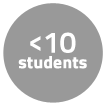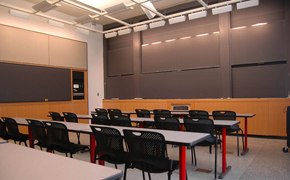Instructor Insights pages are part of the OCW Educator initiative, which seeks to enhance the value of OCW for educators.
Course Overview
This page focuses on the course WGS.640 Screen Women: Body Narratives in Popular American Film as it was taught by Dr. Emily Fox-Kales and Dr. Suzanne Leonard in Spring 2014.
This course studies contemporary films and media texts, and organizes itself around topics that have been granted considerable purchase in popular culture discourse, including: adolescent sexuality, narratives of pregnancy, portrayals of excessive mothering, diet culture, overweight bodies, body makeovers, racialized bodies, and raunch culture. Media texts have been selected based on their ability to speak to these issues in ways that are relevant to current body preoccupations rather than for their status as “canonical.” The course media texts thus reflect our interest in investigating how contemporary anxieties over the body play out on the popular culture stage.
Course Outcomes
Course Goals for Students
The course is designed to demonstrate that studying popular culture objects as texts in themselves provides valuable insight into current attitudes toward gender and the body. Students can expect to come away from the class with a deeper understanding of the cultural influences that shape media products, cognizance of the effects of media portrayals on the spectator, and familiarity with feminist media theory as it relates to the topic of embodiment and body image.
The most rewarding aspect of team teaching is the opportunity to learn from each other’s expertise in her discipline and thus expand the discourse we share with our students in the area of feminist media studies.
—Dr. Emily Fox-Kales
Below, Dr. Emily Fox-Kales and Dr. Suzanne Leonard describe various aspects of how they taught WGS.640 Screen Women: Body Narratives in Popular American Film.
Instruction and Student Learning
All students submitted weekly discussion questions based on their response to the paired readings and film text for that week. Additionally each student facilitated discussion for the class of a selected syllabus film, for which they then wrote a paper analyzing their film within paradigms presented in the accompanying readings. In preparation for the larger paper submitted at the end of the semester, students first developed a final project proposal 6 weeks prior to its due date in which they designed their primary research investigation and argument together with a working bibliography. Both instructors read and responded to each student’s proposal, drawing upon resources from both feminist media studies and clinical/media psychology (our respective disciplines) and invited students to refine, revise, and in some cases re-submit their proposals to ensure a more productive and rewarding writing experience.
Challenges
In addition to working with a wide range of graduate disciplines and backgrounds, we continued to be challenged in finding the right balance between fostering student-driven conversation and discussion with our own commentaries and teaching. As a teaching team we have developed a style that favors encouraging the former, but it was not always possible to get that balance right for each class meeting and for each student. Last semester we experimented with presenting a brief teacher-led theoretical context based on our respective disciplines at the beginning of class to guide the discussion, in addition to having students divide into break-out groups to address film analysis questions which were then shared with the larger group.
Co-Teaching
Because all GCWS courses are team taught across disciplines, the process of creating both their structure and content is central to course development and delivery.
Sharing ideas and creative planning sessions in establishing and subsequently revising the course since its first iteration continues to be a very positive experience. Equally useful, as noted above, is coming together to discuss each student’s work after first separately reading and evaluating their film presentation paper, final project proposal, and final paper and then arriving at a grade in consultation with each other. Ultimately however the most rewarding aspect of team teaching is the opportunity to learn from each other’s expertise in her discipline and thus expand the discourse we share with our students in the area of feminist media studies.
Curriculum Information
Prerequisites
Students must apply to the Graduate Consortium in Women’s Studies.
Requirements Satisfied
H-Level Graduate Credit ![]()
Offered
WGS.640 is offered intermittently and is considered a special topics course about “Studies in Women’s Life Narratives.” The specific topic changes each time it is taught.
Assessment
The students' grades were based on the following activities:
 20% Weekly discussion questions
20% Weekly discussion questions 30% Oral presentation and paper
30% Oral presentation and paper 50% Final paper
50% Final paperStudent Information

Breakdown by Year
Master’s-level students and doctoral students.
Breakdown by Major
Students came from a wide variety of disciplines, since the coursework is interdisciplinary in nature.
Typical Student Background
Given the interdisciplinary nature of all GCWS courses, we expect to encounter students who represent varying levels of graduate study, with the balance between masters-level and doctoral students shifting from year to year; as well working with students from a wide range of disciplines, which has included architecture, the social sciences, and clinical psychology. In recent years our course drew a large representation of students in advanced degree programs in gender studies and English. We have encountered variability as well in student preparation for the course; some were more immediately comfortable with managing the course expectations and requirements, while other students who were new to media studies took somewhat longer to engage with film analysis and film theory. And while students themselves were initially aware of differing degrees of graduate experience and thematic preparation in their respective disciplines, these differences eventually resolved as a growing sense of the classroom as community developed over the semester. This atmosphere of engagement and support was particularly evident at the final meeting when each student presented a brief overview of their final project to the class.
Enrollment Cap
Each seminar in the Graduate Consortium of Women’s Studies is limited to 20 students.
During an average week, students were expected to spend 12 hours on the course, roughly divided as follows:
Seminar
- Met 1 time per week for 3 hours per session.
- The class time was divided between student-driven conversation and instructor-led commentary.
Out of Class
Students spent their out-of-class time doing the readings, writing weekly discussion questions, preparing oral presentations, and writing a 15-20 page final paper.
Semester Breakdown
| WEEK | M | T | W | Th | F |
|---|---|---|---|---|---|
| 1 |  |  |  |  |  |
| 2 |  |  |  |  |  |
| 3 |  |  |  |  |  |
| 4 |  |  |  |  |  |
| 5 |  |  |  |  |  |
| 6 |  |  |  |  |  |
| 7 |  |  |  |  |  |
| 8 |  |  |  |  |  |
| 9 |  |  |  |  |  |
| 10 |  |  |  |  |  |
| 11 |  |  |  |  |  |
| 12 |  |  |  |  |  |
| 13 |  |  |  |  |  |
| 14 |  |  |  |  |  |
| 15 |  |  |  |  |  |
| 16 |  |  |  |  |  |
| 17 |  |  |  |  |  |
 No classes throughout MIT
No classes throughout MIT Seminar session
Seminar session Student presentations
Student presentations No class session scheduled
No class session scheduled Assignment due date
Assignment due date

 Room 1 of 1
Room 1 of 1 